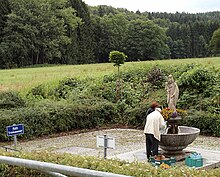Heiligenbrunn (Fürstenzell)
Heiligenbrunn is a place of pilgrimage to Mary in the district of Obereichet near Jägerwirth in the municipality of Fürstenzell near Passau .
The pilgrimage site Heiligenbrunn is located in a large forest clearing in the Neuburg Forest near the village of Jägerwirth . The origins of the pilgrimage can be traced back to the late 16th century. After the place of pilgrimage for centuries consisted mainly of a pond and a wooden chapel next to it, the spring was put in a well in 1964 and a modern granite chapel was built.
history
The pilgrimage to Heiligenbrunn originated in the late 16th century. It can be traced in the archives from 1600 onwards. Around 1676 a wooden chapel was built next to the pond. In the course of secularization , the pilgrimage to Heiligenbrunn was banned on May 1, 1803, the chapel was demolished and the pond drained. At that time, 288 votive tablets , 200 wax votives , 48 hernial bandages , 15 crutches and 15 wooden hearts, livers and lungs were secured in the chapel . On July 2, 1803, on the Feast of the Visitation of the Virgin Mary , 2000 pilgrims were counted again, so that soldiers from Passau were called in to enforce the ban on pilgrimages. But this was only partially successful. By 1818 a wooden chapel had already been built and the pond was restored.
In the first half of the 20th century the flow of pilgrims subsided. After the Second World War , the pilgrimage was revived by the surrounding communities. On February 7, 1964, a chapel building association was founded with the aim of redesigning the chapel and spring. The new granite chapel and the new fountain were consecrated in August of the same year. The architect was Adolf Hiendl from Passau . Between 1998 and 2002 the spring was redesigned and the well area redesigned.
Legends
As is usual with places of pilgrimage, there are legends about the origin of the place of pilgrimage. This is how the pilgrimage is said to have originated after a farmer's daughter from the Griesbach area is said to have been cured of "falling addiction" ( epilepsy ) by the water from the pond . Her father donated the first wooden Marian column on it.
For 1674 it is reported that the landowner filled up the pond and had the image of Mary removed, as he felt damaged by the constant trampling of his meadow. The following night his farm is said to have burned down and the entire livestock perished, whereupon the latter had a wooden chapel built.
Another legend reports that a statue of Mary or a chapel is said to have sunk in the original pond, which is why pilgrims with poles kept looking for them in the pond. When the pond was drained in 1803, however, only a few broken bricks were found.
Trivia
- The well water is explicitly not declared as drinking water . The area around the source would otherwise have to be designated as a water protection area, which would have significant effects on the management of the surrounding fields and meadows. However, the farmer who cultivates the surrounding land, in return, waives fertilization and intensive cultivation of the surrounding land. The current water analyzes are displayed in the showcase at the parking lot.
- The popularity of the water from the source in Heiligenbrunn is due, among other things, to the fact that, in contrast to the calcareous water of the local long-distance water supply, it is much softer and therefore more suitable for making coffee and tea .
literature
- Dionys Asenkerschbaumer, Alois Brunner, Ludger Drost, Andreas Paul, Klaus Metzl: voyages of discovery in the diocese of Passau. Treasures, valuables, curiosities Passauer Bistumsblatt, Passau 2011, ISBN 978-3-9813094-3-0 .
Web links
- Official homepage of the parish Jägerwirth with photos of the complex before 1964
- http://www.heiligen-brunn.de/ More information and photos on the special page of the parish Jägerwirth with drinking water test report
Coordinates: 48 ° 34 ′ 27.1 ″ N , 13 ° 19 ′ 32.8 ″ E


